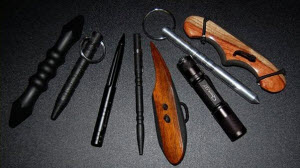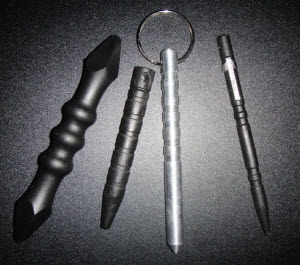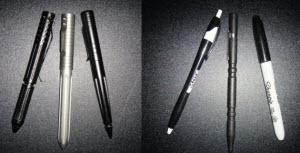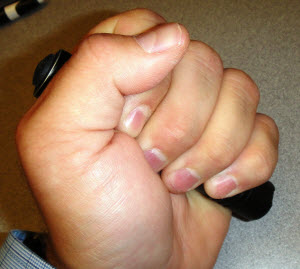
A variety of small, concealable and highly effective impact tools are available today, ranging from traditional to more modern.
SITs share common movements with many practical empty-hand combatives skills, systems and point-driven edged weapon applications. SITs can provide the user with an alternative force option depending upon the circumstances of the situation. Pulling a folding knife out of your pocket and striking with the closed folder are viable applications of non-lethal force, but in some jurisdictions may still be construed as you pulling a lethal-force tool. Some individuals are simply not comfortable carrying or deploying an edged weapon, but embrace the suggestion of a small handheld impact tool without hesitation.
Available Options
While it’s easy to assume that “anything” can be picked up and utilized as a small impact tool during a bad situation, methodology and application have to be trained in order to be dependable under the stress of actual attack. More realistic is to select a specific SIT that can be easily carried with you every day, anywhere you go, without drawing unwanted attention. Once an appropriate SIT has been selected, training in access and utilization of that tool needs to be conducted in order to integrate it into your personal protection profile.

Traditional kubotan-type small impact tools can be effective but may also attract unwanted attention.
In the early 1970s, the traditional handheld kubotan was introduced by Takayuki Kubota specifically for the Los Angeles Police Department. An offshoot of the Japanese Yawara stick or Filipino palm stick, the basic principle is to load into the hand a hard cylindrical object that protrudes from the hand at both the top and bottom. This allows use of these surfaces to maximize the body’s force and direct it into these small protruding points. Kubotans are available in a variety of configurations, lengths and materials, with the most popular today being made of light, durable plastic.
The tactical flashlight market has come a long way since SureFire introduced the original 6P. These high-output, compact and durable handheld flashlights are commonplace throughout law enforcement, military and citizen personal protection industries. Providing a dual purpose for both illumination and SIT, the handheld flashlight can be carried in most daily environments.

Left: Tactical pens like the Tom Anderson Twister, Greg Lightfoot Timberline, and Smith & Wesson Black Tactical Pen come in a variety of styles and price ranges. Right: Standard pens and Sharpie markers can be found in any big box store.
Tactical pens such as the Greg Lightfoot Timberline or Tom Anderson Twister are fairly recent additions to the tactical gear market. Excellent SIT options, these pens can be carried almost anywhere, but their price can be a deterrent. Therefore, do not discount standard metal-barrel pens and hard markers such as the popular Sharpie.
With touch-screen technologies taking over the smart-phone and tablet industries, more and more people are finding the need for a dedicated stylus or pen-shaped instrument. Unfortunately, these styli are often made with poor materials and are less than robust. Instead, consider custom styli such as the Barry Jones Defensive Stylus, which can be highly functional SITs manufactured out of hard wood, metal and durable plastics.
A number of custom knife makers and craftsmen, such as “Nok” of Nok Hard Contact Training Knives, make very attractive and effective small impact tools. Many of these items are patterned after sharp-tipped knives or animal claws and designed for carry in places where knives cannot go. They offer a unique, individual alternative to more commonplace SITs.

Make certain the SIT you choose provides ample surface area for application during reactive personal defense situations.
SIT Considerations
The SIT you choose must be readily available. Like pepper spray or OC, a keychain kubotan is of no use buried at the bottom of a purse or backpack. Expedient SITs like a Sharpie marker or metal-barrel pen can easily be purchased at any big box store when personal-protection everyday carry gear has been forgotten, stolen or is inappropriate for the operational environment.
Make sure the SIT protrudes from both ends of the hand, providing enough surface area to maximize the effect of hammer strikes or point-driven stabbing strikes to soft tissue areas.
Many traditional kubotans, palm sticks and keychain devices are very overt and easily noticed. They can draw unwanted attention from friends and co-workers or provide information about your level of preparedness to potential assailants.
While tactical pens and flashlights are applicable as SITs, TSA and commercial security companies are more aware than ever of these items and their potential uses. Be aware of this and plan accordingly. A standard Sharpie marker, firm metal pen, wooden stylus or letter opener stowed in your carry-on bag will serve the same purpose without giving away your situational preparedness or holding you up. Although I like collecting gear and tactical items, I do my best to not carry them openly when traveling. The highly visible pocket clips found on folding knives, tactical flashlights and tactical pens may be target indicators.
Conclusions
Research and consider integrating a small impact tool into your own or a loved one’s personal defense profile. A tool is better than no tool when it comes to personal protection. Every personal protection tool requires understanding of justifiable use of force and proper, effective application. Remember, it’s not the tool; it’s you, the operator, who makes the tool effective. No matter what type of SIT you choose, seek out training and learn how to maximize your impact during a critical defense incident.


I missed seeing my monkey fist in there. Some of those you showed seemed as obvious to me. Mine is 3/4 inch, and a hit on any bone near the skin's surface could be devastating.